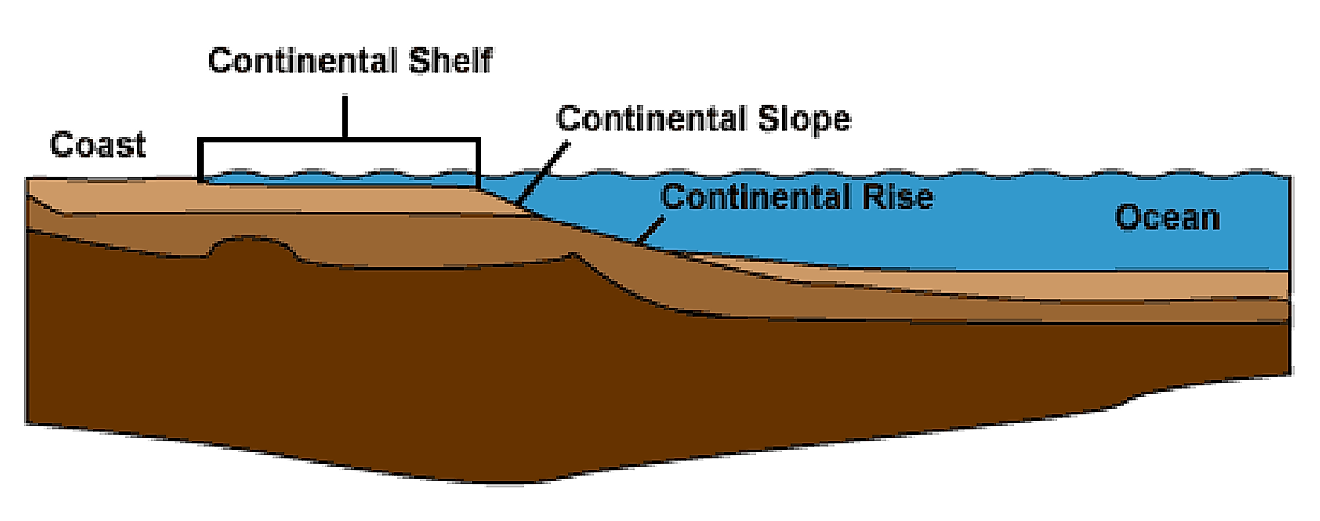What Is A Continental Shelf?

Description
A continental shelf is the edge of a continent lying beneath the ocean. This shelf extends from the coastline of a continent to a drop off point called the shelf break. The shelf break is where the underwater edge of a continent shelf begins to rapidly slope downwards towards the ocean floor depths. From the break, the shelf descends into the deep ocean floor in the form of a continental slope, according to National Geographic Education (NGE). Though beneath the water, continental shelves are still part of their respective continents. Therefore, their edges define the actual boundaries of the earth's continents, not the visible coastlines.
Size of a Continental Shelf
According to the U.S Bureau of Ocean Energy Management, waters in continental shelves are rarely over 500 feet deep, compared to open, deeper ocean waters. The United Nations Convention on the Law of the Sea stipulates that every nation’s continental shelf over which they have exclusive economic sovereignty shall not be exceeding 200 nautical miles from any given nation’s coastline. Widths of continental shelves vary, but their average width is 40 miles before giving way to deeper open ocean waters.
Formation of Continental Shelves
Initially, continental shelves were dry land. However, over several millions of years, organic and inorganic materials combine to form them as sea levels rise. There was a buildup of inorganic material when rivers carried sediments like rocks, soil, and gravel to the edges of the continents and then into the oceans. The inorganic sediments accumulated in layers at the continental edges, as well as organic materials like plant and animal remains. According to scientists, over the course of 18,000 years during the peak Ice Age, when much of water on the earth was frozen, sea levels dipped and exposed the continental shelves. During the ice age, researchers say, sea levels were 100 meters lower than in our modern day according to NGE.
Benefits of a Continental Shelf
Continental shelves see many of their fossil fuel reserves offshore drilled to meet the energy needs of the world. According to NGE, 30 percent of oil, and 20 percent of natural gas, produced in the U.S are sourced from offshore drilling. These offshore sites are on the North American continental shelf, including those off of the Mexican Gulf and Alaskan coasts. Continental shelves make up less than 10 percent of the total area of the oceans. However, most of the ocean’s aquatic plants, animals, and algae live in them due to their abundance of sunlight, shallow waters, and nutrient-rich sediment flowing into them from river outflows. As a result, microscopic shrimp and such important fish species as tuna, menhaden, cod, mackerel, and others thrive in and around continental shelves, according to Marine Bio. Kelp, a giant seaweed, algae, and aquatic plants grow to be food sources at the base of aquatic creatures' food chains. As a result, continental shelf areas provide 90 percent of the fish produced in the world according to various studies.
Laws Governing Continental Shelves
To avoid disputes among coastal nations, the United Nations (UN) in 1982 drafted laws and orders to govern continental shelves. These laws gave coastal states the sovereign rights to areas along their coastlines, within which to explore and exploit the shoreline for at least 200 nautical miles from their shores. Beyond that, any revenues gained from one nation’s exploits are to be shared with the international community. In terms of research, the UN stipulated that any marine research conducted in the exclusive economic zone (the 200 nautical mile extension) along the continental shelf to be subject to the consent of the coastal state, even if it’s conducted for peaceful purposes.











